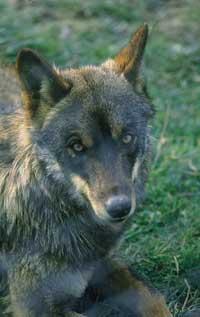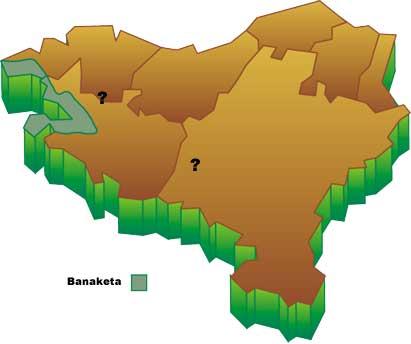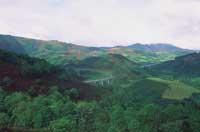Problem and wolf conservation (and 2)
1997/03/01 Elosegi Irurtia, Migel M. Iturria: Elhuyar aldizkaria

Of course, getting what will happen next is not difficult. The tall wolf will eat his grandmother and the murder Txanogorritxu will also suffer a serious alarm. Although the most captive is only an ancient tale, it is very representative. Because young children learn to consider the wolf as an evil animal and the seed to feel fear and hatred in the future is sown.
Since the man became a shepherd, the wolf has eaten the sheep, he has a great discomfort with this “beast.” This problem, however, disappeared in the middle of this century in the Basque Country, since in 1923 in Urbasa, in 1955 in Gibijo, and in 1967 killed the last wolves of Turtzioz. Since then, the shepherds have been able to leave the sheep calmly at night and have had a more comfortable life. But in recent years what seemed a lie has happened. The animal that disappeared from our map, without any effort, has begun to enter by the west, Burgos and Cantabria, and also by Soria.
First, we have to say that this news is gratifying, because the barrier effect generated by the media of this last century is not total, and because it shows that our environment can still be suitable for this predator. After entering, however, there was an intense debate between the defence and the opposition of the wolf.
But we will see in figures the damage produced by this magnificent animal. According to experts, 2,000 wolves in the Spanish state kill every year 5,000 sheep, 400 cattle and 1,000 horses, which means a loss of 120 million pesetas. Through a simple division we can conclude that each wolf produces annual damage of 60,000 pesetas, but it has also been possible to affirm that these damages are very variable. For example, each wolf of the Sierra Cantabrian has an impact of 250,000 pesetas a year and to the south, in the area of Castile, each wolf has between 10 and 15,000 pesetas. According to experts from the Basque Country, between October 1992 and August 1994, the wolves killed 179 heads of cattle, 35 were injured and 86 disappeared, causing damages of 2,550,000 pesetas.

It is curious to know that there are animals that cause more damage than wolves. Many insects or wild boars, for example, even if they cause further damage, do not attract media attention or trigger certain hatred among peasants. Wild boars may approach the fields randomly and often, do not cause excessive destruction to each farmer, while wolves, in a single night, can damage the entire heritage of a shepherd, causing much greater anger. However, it is curious that some animals, even as harmful as others, do not generate hatred.
Following the statistics, we can conclude that each wolf kills about 3 cabins on average every year, but exploiting the killings, they eat more domestic cattle than they kill. However, it is possible that wolves operating in Euskal Herria, being young and inexperienced, cause greater harm than those described. On the demand side, for example, it has been observed that each wolf kills 7.6 sheep a year and those in these areas could do so similarly. If we mentioned the damage, it would also be good to see if the wolves can do any favor.
These predators carry out the control and improvement of ungulated populations, highlighting the populations of balanced foxes present in the territories of wolves and the scarcity or lack of wild dogs. In any case, we will proceed to analyze the possibilities that can be taken before this problem. Come on.

One of the options would be to return to the previous situation, that is, decide that the wolf has no place here and act until the last number dies. To a certain extent this may be what we are doing today, since every year we die about 5 wolves of the western populations that are heading here, and although it is settled in some regions of our territory, this animal is not included in the list of threatened vertebrates of the Autonomous Community of the Basque Country.
On the other hand, the scarce presence of this animal in western Europe makes it proposed its total protection, recovering this treasure for the heritage of our fauna. According to this option, the damage to the shepherds would be paid generously and would be left in the place where the wolves are. However, Basque pastors would not easily accept this way of life in places like Aralar or Urbasa. In such a human environment, the hunting pieces of wolves would be largely animals and this profession in bad condition could plunge into an unsustainable situation.
Let us try, however, to plan an intermediate situation that, despite its difficulty, allowed the conservation of wolves and shepherds. First of all, in all areas where the wolf attack occurs and at all times there would be rapid compensation to the shepherds. Not only of dead sheep; of the lost, of the disappeared, of stress, and of the fall of production and fertility. But we would control the wolves that kill many animals. Why?
On the one hand, so that these fast animals learn that the approach to animals is dangerous and, on the other hand, so that they feel accompanied by the shepherds, so that their despair and hatred are bleached in part, and most importantly, so that they do not return to dangerous activities such as poisons. However, it is possible that in some mountain range of small human population, such as the Navarrese Pyrenees or some Alava region, the wolf passes almost unnoticed and feeds on roe deer, wild boars and others. These copies, of course, would be left in peace.

Finally, on the part of the shepherds, the fact that the repair of the dead sheep is carried out generously, quickly and without generating any burukomini, would be a commitment of effort in the care of the sheep. It may be appropriate to grant assistance for the possession of herders in herds or dogs of the mastiff breed, since they are very appropriate to combat the attacks of the wolf. Unfortunately, as in the last two generations pastors have not had contact with wolves and lead a much more comfortable life, they will not accept more work. It is to be assumed, therefore, that the wolf, the most outstanding wild predator of the Basque Country, will be carried on the fame of vulgar, wild and diminutive of all life and that in no case we will allow him to settle in our territory. I wish I was wrong!

Gai honi buruzko eduki gehiago
Elhuyarrek garatutako teknologia





